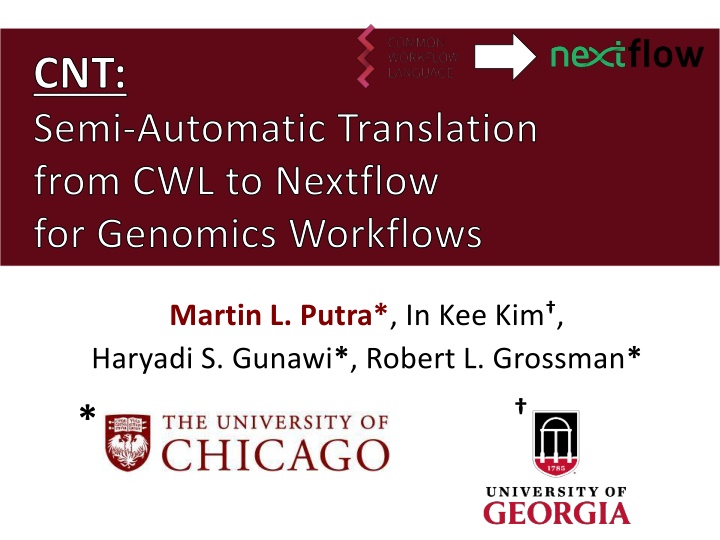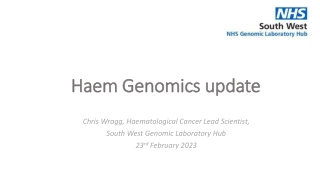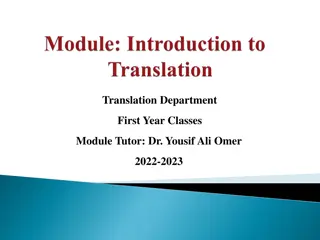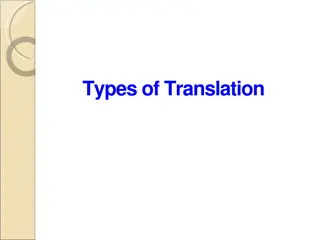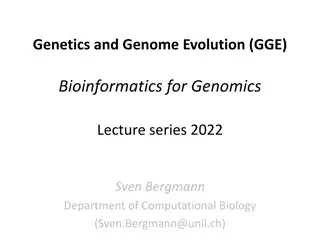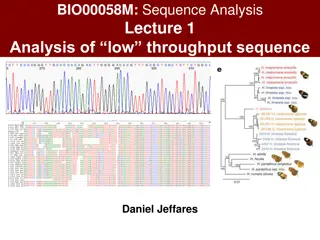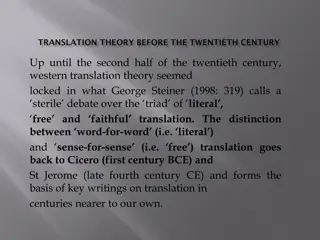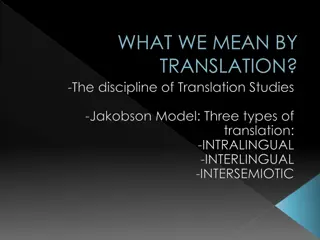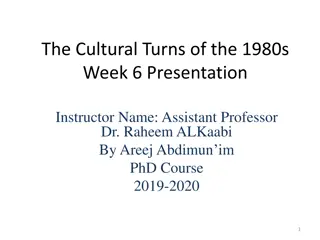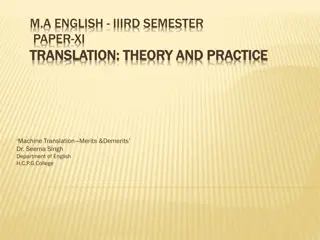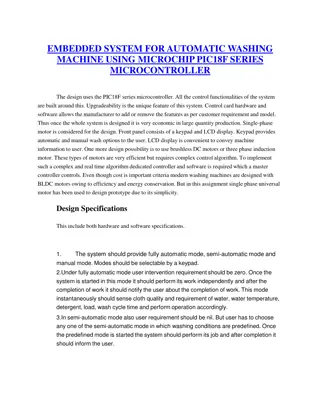Semi-Automatic Translation from CWL to Nextflow for Genomics Workflows
Explore the CNT tool enabling semi-automatic translation from Common Workflow Language (CWL) to Nextflow for genomics workflows. Understand the benefits, challenges, and workflow execution aspects for efficient genomics pipeline development and automation.
Download Presentation

Please find below an Image/Link to download the presentation.
The content on the website is provided AS IS for your information and personal use only. It may not be sold, licensed, or shared on other websites without obtaining consent from the author.If you encounter any issues during the download, it is possible that the publisher has removed the file from their server.
You are allowed to download the files provided on this website for personal or commercial use, subject to the condition that they are used lawfully. All files are the property of their respective owners.
The content on the website is provided AS IS for your information and personal use only. It may not be sold, licensed, or shared on other websites without obtaining consent from the author.
E N D
Presentation Transcript
CNT: Semi-Automatic Translation from CWL to Nextflow for Genomics Workflows Martin L. Putra*, In Kee Kim , Haryadi S. Gunawi*, Robert L. Grossman* *
2 CNT @ BIBE 23 Two popular workflow languages CWL Used in many production-grade genomics workflows. Has been around longer, wider user base Decoupled from any workflow engine. Nextflow Rising in popularity Coupled with its own workflow engine. Native supports for parallelworkflow execution.
3 CNT @ BIBE 23 Parallel Workflow Execution 2 1 5 3 4 Can be executed concurrently. Sequential Workflow Execution 1 3 2 5 4 Order of {2, 3, 4} might vary depending on workflow engine.
4 CNT @ BIBE 23 Let s use Nextflow Production system using CWL Uhh .. Sure Manual Translation Dataflow programming model Nextflow syntax & operators Javascript Groovy Automate?
5 CNT @ BIBE 23 The Need for Automatic Translator Manual translation is time-consuming and requires domain-specific expertise. No existing tools for automatic translation. We propose CNT, the first semi-automatic translator from CWL to Nextflow.
6 CNT @ BIBE 23 Let s use Nextflow Production system using CWL Oh, sure! Our solution: CNT Cwl-to-Nextflow Translator Tool & workflow-level translation Partially handle JavaScript Automate?
7 CNT @ BIBE 23 CNT High similarity High coverage High performance gain* *Evaluated against a sequential workflow engine.
8 Outline Challenges Fully Automatic Translation Semi-automatic Translation Evaluation Conclusion
9 Outline Challenges
10 CNT @ BIBE 23 Workflow as DAG 2 1 5 3 4 Analysis Step Flow of data
11 CNT @ BIBE 23 Challenge #1: Exploration & ordering of subworkflows. A step can be a (sub)workflow 2 1 5 3 4 =Step is a single tool. =Step is a subworkflow.
12 CNT @ BIBE 23 Challenge #1: Exploration & ordering of subworkflows. 2 1 5 3 4 =Step is a single tool. =Step is a subworkflow.
13 CNT @ BIBE 23 Challenge #1: Exploration & ordering of subworkflows. Another subworkflow to explore! 2 1 5 3 4 2c 2b 2a 2d up to arbitrary depth. =Step is a single tool. =Step is a subworkflow.
14 CNT @ BIBE 23 Challenge #2: Ordering of input & output variables. Difference in invocations: CWL: named arguments. Nextflow: positional arguments. 2 1 5 3 4
15 CNT @ BIBE 23 Challenge #2: Ordering of input & output variables. Difference in invocations: CWL: named arguments. Nextflow: positional arguments. Order affects invocation! CWL Nextflow 2 Step1: -out: 1a: X 1b: Y 1c: Z Process Step2 { file 2b file 2c var 2a } 1 5 3 4 Step2: -inp: 2b: 1b 2a: 1a 2c: 1c Step2(1b, 1c, 1a)
16 CNT @ BIBE 23 Challenge #3: Scripting Languages. Javascript usage is complex and pervasive. Translation to groovy or nextflow operators. arguments: - valueFrom: | ${ function to_rg() { var readgroup_str = "@RG"; var keys = Object.keys(inputs.readgroup_meta).sort(); for (var i = 0; i < keys.length; i++) { var key = keys[i]; var value = inputs.readgroup_meta[key]; if (key.length == 2 && value != null) { readgroup_str = readgroup_str + "\\t" + key + ":" + value; } } return readgroup_str } Example of JavaScript in CWL
17 CNT @ BIBE 23 Summary of Challenges C1. Exploration & ordering of subworkflows. C2. Ordering of input & output variables. C3. Scripting language.
18 CNT @ BIBE 23 CNT: Summary of Design Challenges Automatic/Manual Exploration & Ordering of Subworkflows Automatic #1 Ordering of Input/Output Variables Automatic #2 #3 Scripting Language Automatic, Manual
19 Outline Fully Automatic Translation
20 CNT @ BIBE 23 Fully Automatic Translation 1 2 3 Graph-dependency Analysis Correctness Check Tool-level Translation
21 CNT @ BIBE 23 Fully Automatic Translation 1 2 3 Graph-dependency Analysis Correctness Check Tool-level Translation
22 CNT @ BIBE 23 Tool-Level Translation Gather all CWL files by doing recursive exploration. Classify CommandLineTool vs Workflow files. CommandLineTool == single tool Workflow == subworkflow For each CommandLineTool, call tool-level- translation module. If Workflow, repeat recursive exploration. Correctness Check Tool-level Translation Fully Automatic Translation: Ch#1, Ch#2 Graph-dependency Analysis
23 CNT @ BIBE 23 Tool-Level Translation 2 1 5 3 4 Step Type Path 1 Tool < > 2 Workflow < > Correctness Check Tool-level Translation Graph-dependency Analysis =Step is a single tool. =Step is a subworkflow. Fully Automatic Translation
24 CNT @ BIBE 23 Tool-Level Translation 2 1 5 3 4 Step Type Path 1 Tool < > 2 Workflow < > Correctness Check Tool-level Translation Graph-dependency Analysis =Step is a single tool. =Step is a subworkflow. Fully Automatic Translation
25 CNT @ BIBE 23 Tool-Level Translation 2 2c 1 5 3 2b 2a 4 2d Step Type Path 1 Tool < > 2 Workflow < > 2a Tool < > 2b Tool < > 2c Workflow < > Correctness Check Tool-level Translation Graph-dependency Analysis 2d Tool < > Fully Automatic Translation
26 CNT @ BIBE 23 Tool-Level Translation [Tool-level Translation Module] More details on our paper! Correctness Check Tool-level Translation Graph-dependency Analysis Fully Automatic Translation
27 CNT @ BIBE 23 Fully Automatic Translation 1 2 3 Graph-dependency Analysis Correctness Check Tool-level Translation
28 CNT @ BIBE 23 Graph-dependency analysis CWL s named-arguments invocation abstract away positional information. Insight: possible to reconstruct given suitable data structure. 2 1 5 3 4 Correctness Check Tool-level Translation Graph-dependency Analysis Fully Automatic Translation
29 CNT @ BIBE 23 Graph-dependency analysis Create DAG data structure. Input & output variable names as vertex attribute. Store both caller s and callee s perspective. Reconstruct type signature by traversing edges and reconciling caller s/callee s perspective. Correctness Check Tool-level Translation Graph-dependency Analysis Fully Automatic Translation
30 CNT @ BIBE 23 Fully Automatic Translation 1 2 3 Graph-dependency Analysis Correctness Check Tool-level Translation
31 CNT @ BIBE 23 Correctness Check Variable type is important for intermediate data staging. Tracks files, ensuring proper variable type (i.e. File or Path ). Correctness Check Tool-level Translation Graph-dependency Analysis More details on our paper! Fully Automatic Translation
32 Outline Semi-automatic Translation
33 CNT @ BIBE 23 Semi-Automatic Translation Focus: JavaScript expressions Regex-based automatic classifier: Pattern #1: Object attribute access. Pattern #2: Object method call. Pattern #3: Actual code block. 1 Attribute Access Semi- automated handling <Auto Translated> JS Code 2 Method Call Automatic Classifier 3 Actual code block Manual with guideline Final Result
34 CNT @ BIBE 23 Semi-Automatic Translation Focus: JavaScript expressions Regex-based automatic classifier: Pattern #1: Object attribute access. Pattern #2: Object method call. Pattern #3: Actual code block. Uses non-exhaustive mapping table 1 Attribute Access Semi- automated handling <Auto Translated> JS Code 2 Method Call Automatic Classifier 3 Actual code block Manual with guideline Final Result
35 Outline Evaluation
36 CNT @ BIBE 23 Evaluation MD5 Similarity Translation Coverage Performance gain
37 CNT @ BIBE 23 MD5 Similarity Two production workflows: GDC DNA-Seq & RNA-Seq alignment. High MD5 similarity for both.
38 CNT @ BIBE 23 Translation Coverage 73%-81% fully automated. Expected to reduce ~75% development time.
39 CNT @ BIBE 23 Performance Gain* *Compared against cwltool, a sequential CWL workflow engine. Speedup: Avg. of 52.5% for RNA-Seq Avg. of 30% for DNA-Seq CPU Utilization: Avg. of 65% for RNA-Seq Avg. of 25.5% for DNA-Seq.
40 Outline Conclusion
41 CNT @ BIBE 23 Conclusion The first semi-automatic translator from CWL Nextflow. High translation accuracy and coverage. Potential to reduce development time and increase job processing throughput.
42 Thank you! Questions?
44 CNT @ BIBE 23
45 CNT @ BIBE 23
